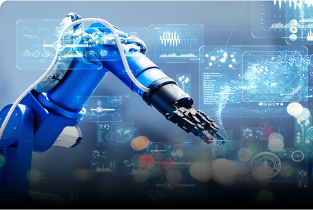The agricultural sector is at the cusp of a technological revolution, with Artificial Intelligence (AI), Robotics, and the Internet of Things (IoT) paving the way for smarter and more efficient farming practices. These innovations promise to address critical challenges such as food security, climate change, and resource optimization. Here’s how these cutting-edge technologies can be integrated into agriculture to revolutionize the industry.
1. Smart Farming with IoT
IoT devices are becoming indispensable in modern agriculture. By deploying sensors across fields, farmers can monitor soil moisture, temperature, humidity, and nutrient levels in real-time. These IoT systems enable precision farming by providing actionable insights:
- Soil Monitoring: IoT sensors measure soil conditions, helping farmers decide when and how much to irrigate or fertilize.
- Weather Forecasting: IoT devices can collect data on microclimatic conditions, enabling farmers to plan planting and harvesting activities more effectively.
- Livestock Tracking: Wearable IoT devices on animals monitor their health, movement, and feeding patterns, improving herd management.
2. AI for Predictive Analytics
AI-driven algorithms analyze vast amounts of agricultural data to make predictions and optimize operations:
- Crop Yield Prediction: AI models analyze historical and real-time data to forecast crop yields, enabling better planning and resource allocation.
- Pest and Disease Detection: AI-powered image recognition tools identify pests and diseases early, allowing timely interventions.
- Market Insights: AI systems analyze market trends to provide farmers with insights on pricing, demand, and supply, helping them make informed decisions.
3. Robotics for Automation
Robotics plays a pivotal role in automating labor-intensive tasks, enhancing productivity and reducing costs:
- Autonomous Tractors: These self-driving machines can plow, plant, and harvest with minimal human intervention.
- Robotic Harvesters: Robots equipped with advanced sensors and AI algorithms can pick fruits and vegetables with precision, reducing waste and damage.
- Weed Control Robots: Using AI, these robots identify and eliminate weeds without harming crops, reducing the need for chemical herbicides.
4. Integrated Systems for Sustainability
Combining AI, Robotics, and IoT creates a holistic approach to sustainable farming:
- Water Conservation: IoT sensors and AI algorithms optimize irrigation schedules, reducing water waste.
- Energy Efficiency: AI-powered systems monitor energy usage in farming operations, identifying opportunities for savings.
- Reduced Chemical Usage: Robotics and IoT-enabled precision farming minimize the overuse of fertilizers and pesticides, promoting eco-friendly practices.
5. Challenges and Considerations
While the benefits are immense, integrating AI, Robotics, and IoT in agriculture comes with challenges:
- High Initial Costs: The adoption of these technologies requires significant investment.
- Technical Expertise: Farmers need training to use and maintain these advanced systems.
- Data Security: IoT systems generate massive amounts of data, necessitating robust cybersecurity measures.
6. The Road Ahead
To make these technologies accessible and effective, collaboration among stakeholders is crucial:
- Government Policies: Subsidies and incentives can encourage farmers to adopt these innovations.
- Private Sector Involvement: Tech companies can develop affordable and user-friendly solutions tailored to farmers’ needs.
- Educational Initiatives: Training programs can equip farmers with the skills needed to leverage these technologies.
Conclusion
Integrating AI, Robotics, and IoT in agriculture has the potential to transform the sector, making it more productive, sustainable, and resilient. By addressing existing challenges and fostering innovation, these technologies can help secure the future of farming in an increasingly unpredictable world. The agricultural revolution is here—and it’s powered by technology.

